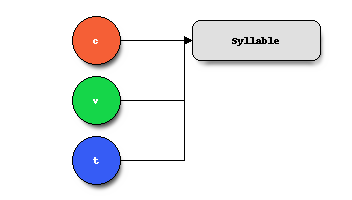1. CVT¶

The mental model of RPA is with understanding the so-called CVT (Consonant, Vowel, Tone) composition of a syllable. For all intents and purposes, a syllable is simply a sound. Hmong is a language, like Mandarin, that is largely mono-syllabic; meaning, one sound is one word. Of course, there are multi-syllable words in Hmong too, but, these words themselves are composed of the elementary mono-syllables. After you learn the mono-syllables, this achievement paves the way to learning compound words in Hmong.
Back to CVT. Simply stated, a consonant is the beggining of a word, a vowel is the middle of a word and a tone is the ending of a word. For more technical articles of these concepts, see the following constant, vowel and tone articles. In RPA, there are only so many consonants, vowels and tones. In fact, there are
56 consonants,
13 vowels, and
7 tones.
Mathematically, there are 5,096 (\(56 \times 13 \times 7\)) possible permutations of syllables that may be created using these finite sets of consonants, vowels and tones.
Note
RPA’s CVT approach to creating syllables is not perfect. There are sounds that cannot be spelled using the CVT approach. Such sounds include those used in rituals and/or religious activities.
However, some words do not have a consonant. Meaning, we have 91 (\(13 \times 7\)) possible syllables without a consonant. In all, there are 5,187 (\(5,096 + 91\)) total possible syllables.
Going further, some words are just vowels. So, actually, there are 5,200 (\(5,187 + 13\)) total possible syllables in RPA.
Note
The CVT mental model of Hmong syllables and/or words is so powerful that many other Hmong writing systems are modeled using this approach. For example, the famous Phaj Hauj script uses TCV (the tone comes first) to model writing syllables.
Let’s dive into the consonants, vowels and tones.
1.1. Consonants¶
Consonants, again, are the beggining of a sound (or word). In RPA, it is convenient to parition consonants into the number of letters that a consonants have.
c, d, f, h, k, l, m, n, p, q, r, s, t, v, x, y, z
ch, dh, hl, hm, hn, kh, ml, nc, nk, np, nq, nr, nt, ny, ph, pl, qh, rh, th, ts, tx, xy
hml, hny, nch, nkh, nph, npl, nqh, nrh, nth, nts, ntx, plh, tsh, txh
nplh, ntsh, ntxh
In RPA, consonants are called tsiaj ntawv txiv. The families of consonants and their English and Hmong names are shown below.
Number of Letters |
English |
Hmong |
|---|---|---|
1 |
|
|
2 |
|
|
3 |
|
|
4 |
|
|
1.2. Vowels¶
Just as in Mandarin and English, all words have vowels. In RPA, all syllables (or words) have one of the following vowels. Again, we group them into the number of letters that composes the vowels and list them alphabetically.
a, e, i, o, u, w
ai, au, aw, ee, ia, oo, ua
In RPA, vowels are called tsiaj ntawv niam.
Number of Letters |
English |
Hmong |
|---|---|---|
1 |
|
|
2 |
|
|
1.3. Tones¶
There are 7 tones in RPA. The Hmong language is sometimes called the tonal champion of East Asian languages for having so many tones. Compare the Hmong language with 7 tones to Mandarin, which has 4 tones. The tones are as follows.
Tone |
Marker |
Example |
|---|---|---|
High falling |
j |
poj |
Low |
s |
pos |
Mid rising |
v |
pov |
Creaky |
m |
pom |
Low falling breathy |
g |
pog |
High |
b |
pob |
Mid |
_ |
po |
Warning
The tone represented by the underscore _ is really blank, but denoted here with an underscore to make it explicit. The underscore is never used to represent a tone and will be omitted later; the context will make it clear.
Note
Sometimes d is also used as a tone!
In RPA, tones are called tsiaj ntawv cim.